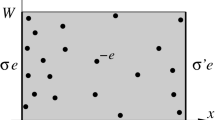Abstract:
Using Monte Carlo simulations, we study the counterion distribution close to planar charged walls in two geometries: i) when only one charged wall is present and the counterions are confined to one half-space, and ii) when the counterions are confined between two equally charged walls. In both cases the surface charge is smeared out and the dielectric constant is the same everywhere. We obtain the counterion density profile and compare it with both the Poisson-Boltzmann theory (asymptotically exact in the limit of weak coupling, i.e. low surface charge, high temperature and low counterion valence) and the strong-coupling theory (valid in the opposite limit of high surface charge, low temperature and high counterion valence) and with previously calculated correction terms to both theories for different values of the coupling parameter, thereby establishing the domain of validity of the asymptotic limits. Gaussian corrections to the leading Poisson-Boltzmann behavior (obtained via a systematic loop expansion) in general perform quite poorly: At coupling strengths low enough so that the Gaussian (or one-loop) correction does describe the numerical deviations from the Poisson-Boltzmann result correctly, the leading Poisson-Boltzmann term by itself matches the data within high accuracy. This reflects the slow convergence of the loop expansion. For a single charged plane, the counterion pair correlation function indicates a behavioral change from a three-dimensional, weakly correlated counterion distribution (at low coupling) to a two-dimensional, strongly correlated counterion distribution (at high coupling), which is paralleled by the specific-heat capacity which displays a rounded hump at intermediate coupling strengths. For the case of counterions confined between two equally charged walls, we analyze the inter-wall pressure and establish the complete phase diagram, featuring attraction between the walls for large enough coupling strength and at intermediate wall separation. Depending on the thermodynamic ensemble, the phase diagram exhibits a discontinuous transition where the inter-wall distance jumps to infinity (in the absence of a chemical potential coupling to the inter-wall distance, as for charged lamellae in excess solvent) or a critical point where two coexisting states with different inter-wall distance become indistinguishable (in the presence of a chemical potential, as for charged lamellae with a finite fixed solvent fraction). The attractive pressure decays with the inter-wall distance as an inverse cube, similar to analytic predictions, although the amplitude differs by an order of magnitude from previous theoretical results. Finally, we discuss in detail our simulation methods and compare the finite-size scaling behavior of different boundary conditions (periodic, minimal image and open).
Similar content being viewed by others
Author information
Authors and Affiliations
Additional information
Received 6 November 2001
Rights and permissions
About this article
Cite this article
Moreira, A., Netz, R. Simulations of counterions at charged plates. Eur. Phys. J. E 8, 33–58 (2002). https://doi.org/10.1140/epje/i2001-10091-9
Issue Date:
DOI: https://doi.org/10.1140/epje/i2001-10091-9




